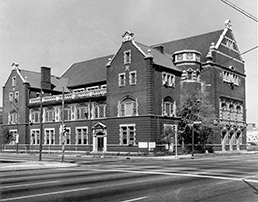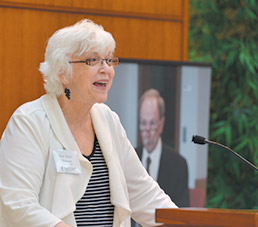Subscriber Benefit
As a subscriber you can listen to articles at work, in the car, or while you work out. Subscribe NowNot quite 50 years have passed since Indiana University’s law school in Indianapolis moved from the Maennerchor Building. The old place is long gone, but some of its last graduates gathered recently to share memories of a time that holds special meaning.
“I think everyone sort of had a common bond,” retired Marion Superior Judge Patricia Gifford said of lawyers who trained in the old downtown hall. “We all worked during the day and went to school at night.”
 From 1945 until 1969, law students in Indianapolis were educated in the Maennerchor Building that was located at the corner of Michigan and Illinois streets. Alumni of the predecessor to Indiana University Robert H. McKinney School of Law recently paid tribute to their former school. (Photo submitted)
From 1945 until 1969, law students in Indianapolis were educated in the Maennerchor Building that was located at the corner of Michigan and Illinois streets. Alumni of the predecessor to Indiana University Robert H. McKinney School of Law recently paid tribute to their former school. (Photo submitted)Gifford was among about 100 graduates of the Maennerchor school who gathered June 18 at Indiana University Robert H. McKinney School of Law to recollect and reconnect.
The Maennerchor, a former German music hall named for a choir still in existence, was the seat of education for aspiring lawyers in Indianapolis, located at the corner of Michigan and Illinois streets. The IU School of Law at Indianapolis affiliated with a predecessor institution, Indiana Law School, and opened in the building in 1945.
The university had recognized a need to train attorneys in the state capital in the postwar years, said Gerald Bepko, retired chancellor of Indiana University-Purdue University Indianapolis.
“The Maennerchor era was so important because it shaped the culture of the law school,” Bepko said. “These were hardworking, honorable people making their way up in the world. If you could create that in a laboratory, you would have something that would be priceless.”
Bepko also was a professor and then dean of the law school at IUPUI in the 1970s and 1980s, after it moved from Maennerchor. The law school initially was housed in Eskenazi Hall, now Herron School of Art, until the McKinney School opened at its current location in 2001.
“I think the school has made an effort to preserve that culture,” Bepko said of the Maennerchor years. “As times change, that’s why it’s important to gather people from that golden era of the law school’s history to rekindle the law school’s spirit, and I think the law school’s done a good job of doing that.”
Graduates during the Maennerchor era went on to become judges, congressmen, and leaders as public servants and in private practice, Bepko said. Notable grads include the late Rep. Andy Jacobs and the late Virginia Dill McCarty, the first woman appointed to a full term as a U.S. attorney, among numerous other firsts.
Also among notable graduates: Indiana Chief Justice Brent Dickson (Class of 1968) and retired attorney and banker Robert H. McKinney, for whom the school now is named. McKinney graduated in 1951.
Indianapolis defense attorney Jim Voyles of Voyles Zahn & Paul worked day jobs while he went to law school at Maennerchor in the evenings, on weekends and in the summertime. “If you wanted to go to law school, that was what you did,” he said.
Voyles keeps a photo of the Maennerchor in his office, and he knows many of his classmates do, too.
“It was just a fabulous old building. It was quaint and old, but it had a lot of character,” Voyles said.
What it didn’t have, among other things, was central air conditioning. “I remember one of the upper classrooms got pretty hot,” Gifford said.
Voyles said professors were accessible and helpful, but also could be tough. “It was academic, but there was a lot of practicality to it – this is what you do as a lawyer.”
Years after law school, Voyles said he was working on a case that gave him occasion to involve his former professor, Lawrence Jegen, who has taught at the law school since 1962.
“I had to call him professor,” Voyles said. “He kept telling me not to, but I had to.”
 Indiana Court of Appeals Senior Judge Betty Barteau talks to classmates and other alums who studied law at the Maennerchor Building in Indianapolis. (Photo submitted)
Indiana Court of Appeals Senior Judge Betty Barteau talks to classmates and other alums who studied law at the Maennerchor Building in Indianapolis. (Photo submitted)Indiana Court of Appeals Senior Judge Betty Barteau was a legal pioneer of sorts, graduating from the school in 1965. Not only was she just one of two women in her class, but she also had been a career woman working for Standard Oil Co. in southwest Indiana while raising four children.
But those weren’t the only nonconventional aspects of her law studies. When she moved with her family to Indianapolis, she had completed only 11 hours of undergraduate study when she applied in 1962 for one of only a couple of openings to attend law school based on test scores and faculty interviews.
When she made the list of finalists to be interviewed, she felt her meeting with faculty went well, but she said she was a little surprised when, “I got a call and they said classes would start Monday.”
“I made some really dear friends,” Barteau said of her days studying at the old school. “This was a small facility and you just knew everybody. You knew the faculty and you even knew the people who worked for the faculty.”
In an era when few women attended law school, Barteau said she never felt discriminated against because of her gender. “I felt like the professors picked on me sometimes, but they picked on everybody.”
Gifford said when she attended, far more women started law school than completed it. She ascribes that to the era.
“I think it was just a time when it was all kind of new to have women lawyers,” she said. “My grandfather was a lawyer and he was very accepting of that, but I had an uncle who was a lawyer, who I think even when I graduated failed to recognize I was in law school,” Gifford said.
“It was a different time,” she surmised, noting that now women are the majority in many law schools.
After its last students graduated in 1969, efforts to save the Maennerchor building came to an end with its demolition in 1974. Barteau expressed the consensus of her classmates: “It’s a damned shame that happened. … It was such a pretty building.”•
Please enable JavaScript to view this content.
